Key takeaways:
- Understanding donor motivations and personal stories fosters deeper emotional connections that go beyond financial contributions.
- Building strong relationships with donors enhances trust and transforms their support into a partnership that fuels the organization’s mission.
- Personalizing communication and recognizing donor contributions can significantly strengthen engagement and commitment to the cause.
- Sharing success stories effectively illustrates the impact of donations, creating a powerful connection between donors and the people they help.
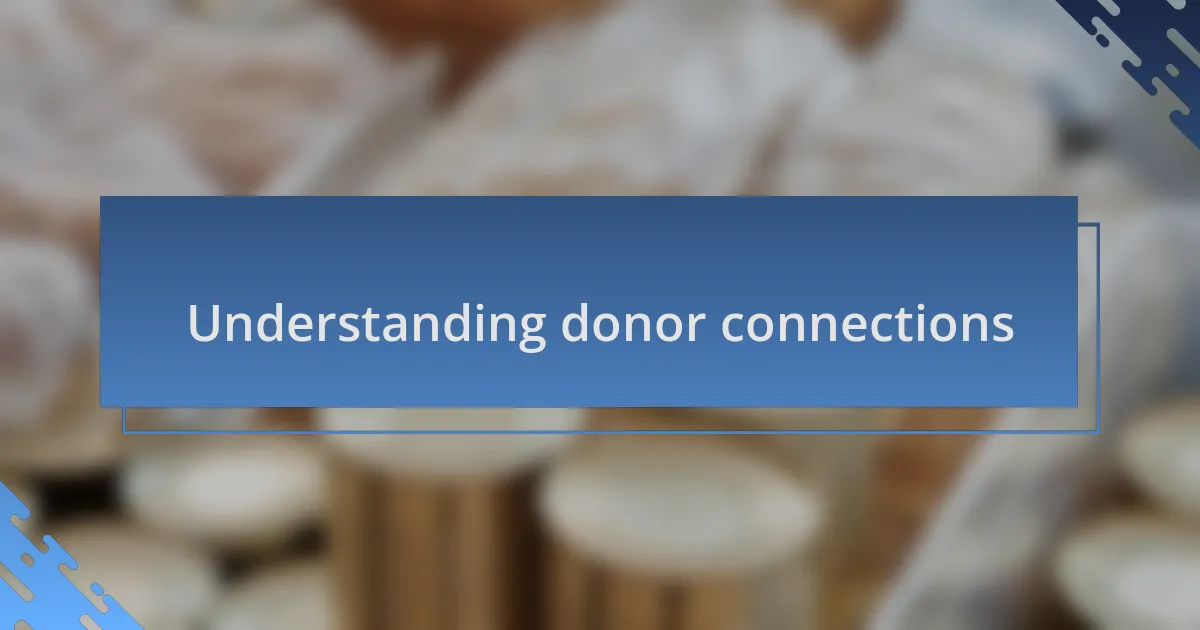
Understanding donor connections
When I first began reaching out to donors, I quickly learned that understanding their motivations was crucial. I remember chatting with a donor who shared a personal story about their struggles with housing instability. That conversation opened my eyes to the emotional connections that often lie beneath the surface. How can we tap into those emotions to motivate them even further?
Every interaction with a donor is an opportunity to create a meaningful bond. I still think back to a moment I spent an afternoon volunteering at a local shelter, where I encountered a donor who connected with a specific family being helped. They shared how their own upbringing shaped their desire to give back. It made me realize that sometimes, it’s not just about the money; it’s about the stories we share and the lives we touch. What if we all looked deeper into those stories?
Building donor connections isn’t just about financial transactions; it’s about trust and shared values. I often reflect on how a heartfelt thank-you note I sent after a generous donation led to a follow-up conversation that deepened our partnership. It’s amazing how simple gestures can lead to richer connections. How are we cultivating these vital relationships in our own journeys?
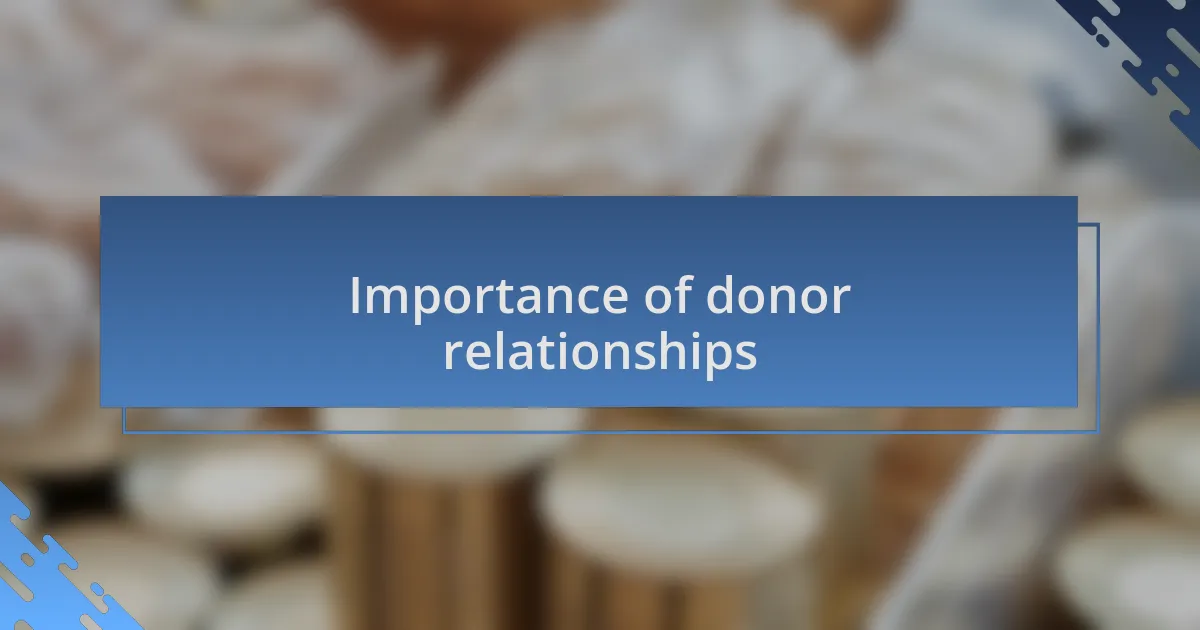
Importance of donor relationships
Building strong relationships with donors is fundamental for the sustainability of our charity efforts. I remember once attending a small gathering where donors were invited to share their thoughts. Listening to each one talk about their unique connections to our mission opened my eyes to the fact that these relationships are built on shared passion and purpose. How can we express gratitude in ways that resonate deeply with each donor?
The support from donors often becomes more than just financial backing; it transforms into a partnership that fuels our work. One donor I spoke with, who had been with us for years, told me how their trust in our organization allowed them to dream bigger about the impact they could make. This interaction reinforced my belief that fostering open communication creates a cycle of trust and impact. Are we fostering that level of openness in our conversations?
When we prioritize donor relationships, we cultivate a community that feels invested in the mission. I recall a time when I took the initiative to invite a donor to see our work in action. Their excitement and renewed commitment afterward illustrated the power of engagement. How often do we see the results of such moments where connection leads to greater involvement? By nurturing these relationships, we not only secure donations but also inspire lasting change together.
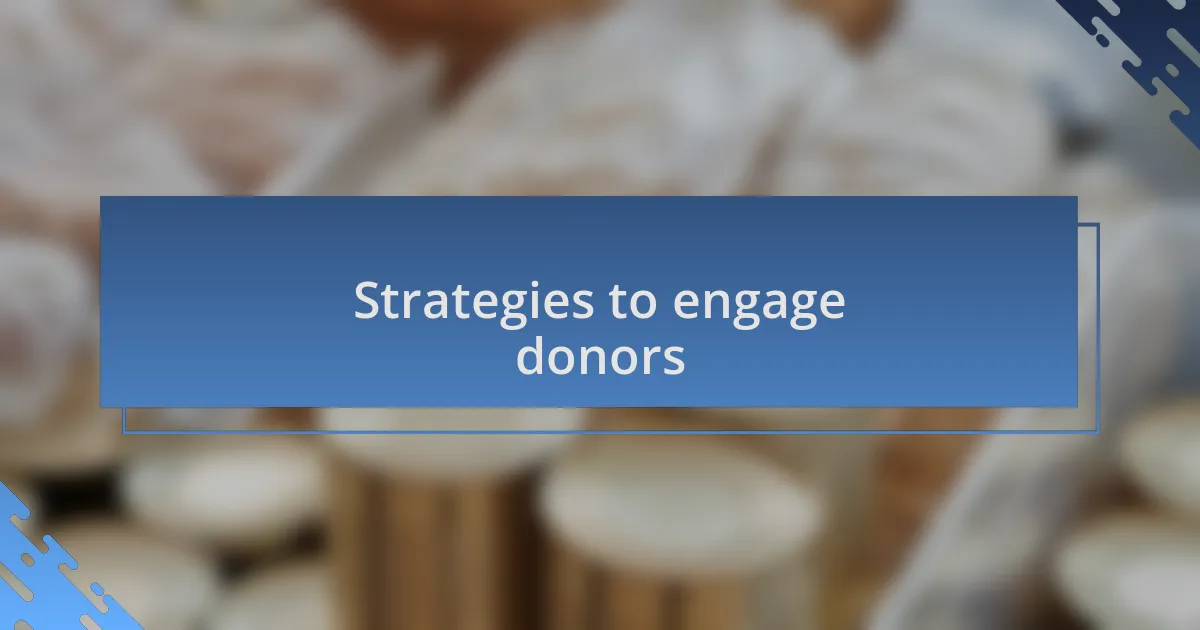
Strategies to engage donors
Engaging donors requires intentionality and creativity. One strategy that has proven effective for me is sharing impactful stories directly from the individuals we serve. During a recent fundraising event, I introduced donors to a family whose life had drastically changed thanks to their contributions. Seeing the emotions on their faces as they heard a first-hand account of hope and transformation connected them to our mission in a way no statistics ever could. How often do we give our donors that kind of emotional experience?
Another approach is to personalize communication with our donors. After receiving a substantial donation, I made it a point to send a handwritten thank-you note, sharing how their specific gift would be utilized. The donor responded with warmth, expressing how rare such gestures are in the philanthropic world. It struck me then that genuine appreciation not only strengthens relationships, but it also encourages donors to feel valued and involved. Isn’t it vital that we make each donor feel like they are an integral part of our journey?
Finally, incorporating donors into our planning can be a game-changer. Inviting them to brainstorming sessions or feedback discussions fosters a sense of ownership over our mission. I distinctly remember a workshop where active donors contributed ideas, leading to innovative programs that none of us had initially considered. This level of engagement not only validates their investment but also creates a community where everyone feels heard. How can we further empower donors to share their insights and become true partners in our mission?
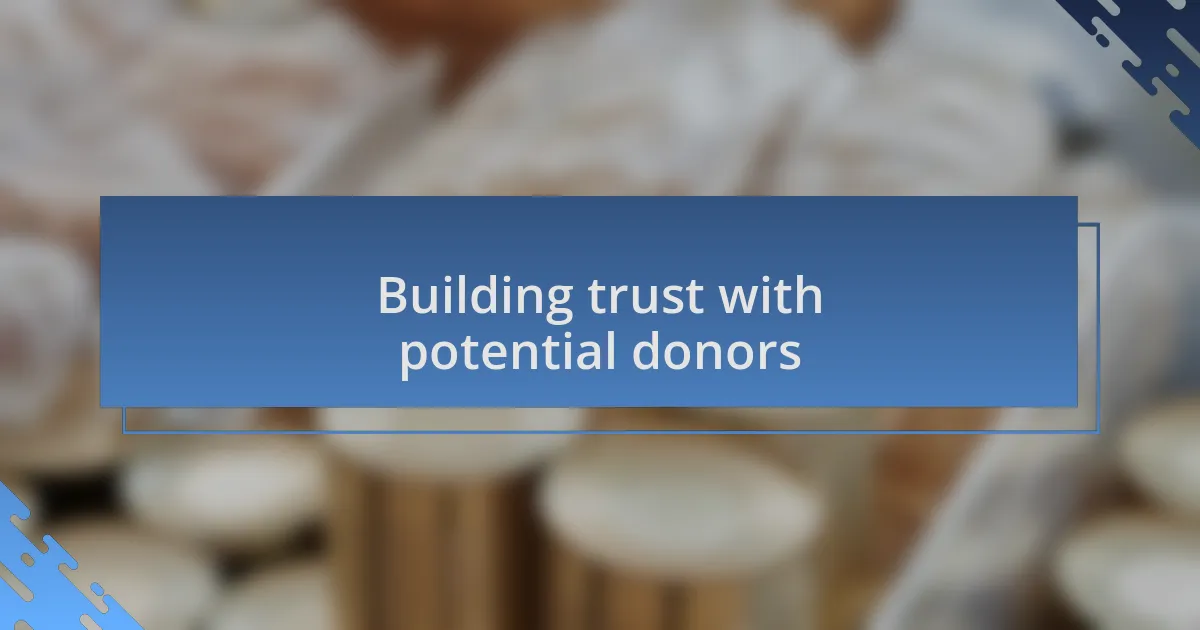
Building trust with potential donors
Building trust with potential donors starts with transparency. I recall a time when I hosted an open house event, guiding visitors through our facilities and showing them exactly how donations were being utilized. When I saw the surprise on their faces—realizing how their contributions immediately impacted lives—it reinforced my belief that open dialogue fosters a deeper connection. Why wouldn’t we want donors to see the ripple effect of their kindness firsthand?
Another essential aspect is sharing our challenges honestly. During a fundraising campaign, I openly discussed the struggles we faced due to unforeseen circumstances, along with our strategies to overcome them. This not only resonated with potential donors but also painted a picture of resilience and determination. It made me wonder: don’t we all appreciate authenticity, especially when it comes to supporting a cause?
I’ve also found that following up with donors, even if they don’t contribute, builds rapport. Recently, I reached out to someone who showed interest but hadn’t donated yet. In our conversation, I learned about their passion for helping the homeless and shared how they could get involved beyond just financial support. These connections emphasized that trust isn’t solely built on financial contributions; it thrives on meaningful interactions and shared values. What better way to cultivate a supportive community?

Personalizing communication with donors
Effective communication with donors goes beyond mere updates; it’s about making them feel personally involved in our mission. I remember sending a handwritten thank-you note to a donor after their contribution helped us provide meals to families in need. The donor replied, sharing their own experiences with homelessness, which highlighted the importance of personal connections. It made me think: how often do we take the time to truly understand the motivations behind our donors’ generosity?
Another key aspect is tailoring messages to fit the unique interests of each donor. For instance, I once spoke to a supporter deeply passionate about education for the homeless. After discussing our literacy programs, I made sure to send follow-up emails that included stories about the students who had benefited. This not only kept the donor engaged but also reinforced their belief in our work. Isn’t it powerful to know that our efforts resonate on a personal level with those who support us?
I’ve also started to create donor spotlights in our newsletters, showcasing not just their contributions but their personal stories and connections to the cause. When one donor shared how their experiences as a volunteer transformed their life perspective, it encouraged others to reflect on their own journeys. How often do we miss out on creating a community that thrives on shared narratives? By lifting up our donors’ voices, we not only express gratitude but also invite a deeper connection that can inspire even greater support.

Sharing success stories with donors
Sharing success stories with donors serves as a powerful tool to reinforce the impact of their contributions. I vividly recall a particular instance when I shared a heartfelt account of a young woman named Sarah, whose life transformed after she found shelter through our program. As I sent this story out in a newsletter, I could almost feel the connection forming between Sarah and our donors. It prompted them to realize that their support was not just financial; it was a lifeline for someone deserving of a second chance. Doesn’t it warm your heart to see tangible results from your generosity?
In another situation, I spoke directly with donors during an appreciation event and shared videos highlighting the successes of individuals who had once experienced homelessness. Watching their reactions was eye-opening; you could see their eyes light up as they realized their contributions enabled countless stories of hope and resilience. This personal interaction conveyed a message more profound than any dollar amount ever could. How can we not feel inspired when we see the faces behind our mission?
Furthermore, I’ve started a practice of regularly updating donors on the long-term impact of their contributions. Recently, I wrote a detailed letter to a donor who had supported our job training program, explaining how one participant landed a job and became a mentor for others. This not only made the donor feel part of a larger narrative but also showcased the ripple effect of their generosity. Don’t you think that knowing your support helps create a chain of positive change is the ultimate reward?
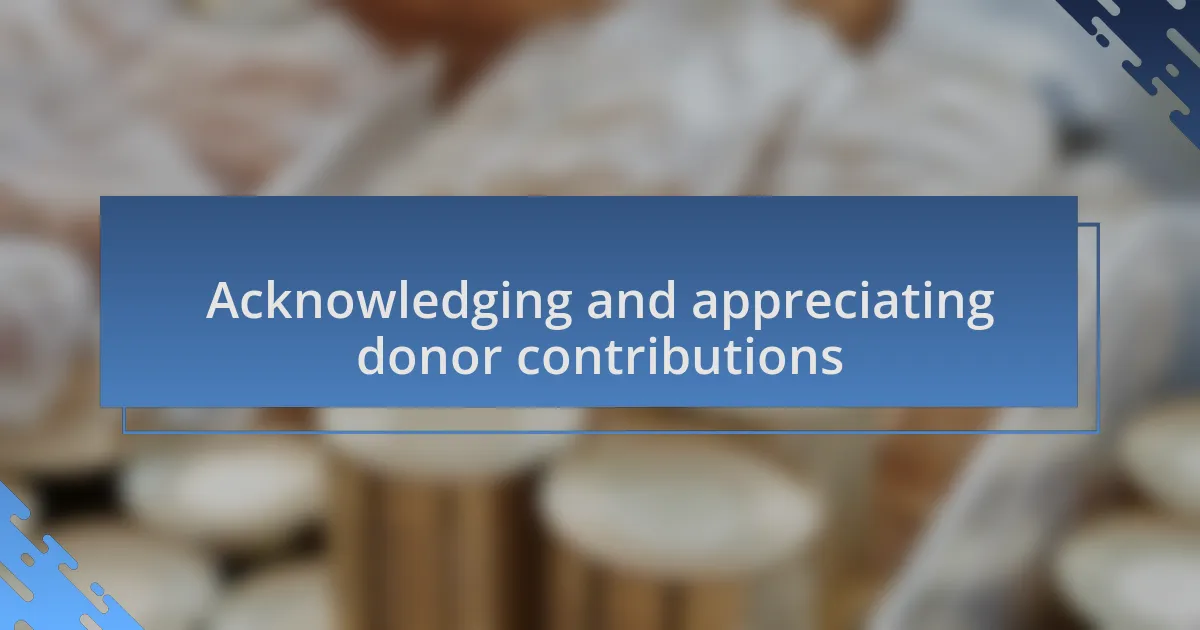
Acknowledging and appreciating donor contributions
Acknowledging donor contributions is not just about saying thank you; it’s about making them feel like key players in a greater mission. I remember one particular donor who began attending our volunteer days. After witnessing the change we were making firsthand, they expressed deep gratitude for being part of the process. This experience illuminated how validation can transform a donor’s view of their impact. Isn’t it incredible to think that a simple acknowledgment can fuel someone’s desire to give even more?
One of my most cherished moments was when I took the time to handwrite notes to our longtime supporters. I recounted their specific contributions and the meaningful outcomes that followed, highlighting how their generosity shaped our programs. Several of them reached out to share how deeply touched they were by the personal touch of these notes. It reinforced my belief that when donors feel recognized, they’re more likely to renew their commitment to our cause. Can you imagine the ripple effect this kind of appreciation can create within a community of supporters?
Moreover, I’ve found that public recognition during events can be incredibly powerful. At our annual gala, we spotlighted several donors and shared brief personal stories about their journeys with us. Watching their faces light up with pride as they received applause from attendees was a beautiful testament to the strong bond that forms through gratitude. Doesn’t it strike you as essential that we gather and celebrate not just our achievements, but also the generous souls behind them?